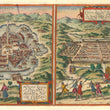


1572 Mexico Regia et Celebris Hispaniae Novae Civitas | Cusco, Regni Peru in Novo Orbe
By: Georg Braun & Frans Hogenberg
Date: 1572 (published) Cologne
Dimensions: 10.5 x 18.25 inches (26.7 x 45.5 cm)
Remarkable pair of views of Tenochititlan and Cusco, the Capital cities of the Aztec and Inca Empires. This pair of maps were the only two cities of the Western Hemisphere, or the New World to be included in the landmark work of Braun & Hogenberg "Civitates Orbis Terrarum," published in 1572.
Tenochtitlan, now the home of Mexico City was built on an island in what was then Lake Texcoco in the Valley of Mexico and was home to the great and ever expanding Aztec Empire. At its time of great prosperity and success, Tenochititlan was by far the largest city in the Americas, some have said it to have been larger than Paris. It had many large and small streets, canals, public buildings, palaces, and marketplaces, some of which that are estimated to have served more than 20,000 people daily and nearly double that on days of feast or human sacrifice.
Hernán Cortés and his men arrived in Tenochititlan on November 8, 1519 with total amazement at the gradure of the city. It wouldn't take long for Cortés to attack the city, but unlike Pizzaro, he did not have immediate success. With the impressive defences and army of Montezuma, he was fought back into retreat. It would not take long however for Cortés to return with a much large army made up of surrounding villages that did not want to live under Aztec rule. This time he constructed battle ships that laid siege on the cities from the lake. For 90 days Cortés cut the city off from food, systematically destroying it while the people inside had nowhere to bury the dead and began to succumb to disease.
Cusco lies deep in the Peruvian Andes, just about 150 miles Northwest of Lake Titicaca, the cradle of the regions' ancient Puraka civilization. The city is most widely known as the capital of the Inca Empire since the 13th century that thrived and controlled many other surrounding villages an cities until the arrival of Francisco Pizzaro in 1533.
Like Cortés, Francisco Pizzaro and his men marveled in astonishment when they first came upon the city of Cusco. In many ways it resembled one of the Old World, with its border walls, high guard towers, monuments, and beautiful edifices, all carved out of stone. The city was laid out in a and grid-like pattern with four roads extending out from the city to the far reached of the Inca Empire. Royalty and dignitaries had their own lovely palaces with guards and servants.
This astonishment of seeing such an advanced civilization deep within the New World did not stop Pizzaro however from immediately sacking the city and capturing their leader, King Atahualpa and holding him for ransom. With only 300 men, the Spaniards managed to cripple the massive Inca army for a number of factors including the advantage of mobility and fear when they arrived on horses covered from head to toe in steal armor. After Pizzaro collected his ransom, he murdered King Atahualpa and ceremoniously anointed a new (fake) king Manco Inca Yupanqui.
Condition: This map is in A condition with full margins, lovely hand coloring over a strong impression. There are no tears or holes, but slight reinforcement of thin paper in the lower margin that does not enter the map image.
Inventory #11642
1200 W. 35th Street #425 Chicago, IL 60609 | P: (312) 496 - 3622




